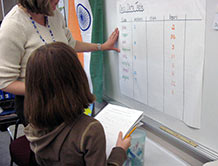How much heavier is one cube than another?
2. Weigh the cubes
Distribute two or three cubes (one metal and one non-metal) to each small group such that all 16 cubes will be weighed. At the same time, have the students retrieve their personal objects for weighing.
Ask a member of each group to bring one of their cubes and take enough washers (or bears or paper clips) to weigh the cube. The students can use “felt weight” to estimate how many units they will need.
| Object | Weight in Paper Clips | Weight in Washers | Weight in Bears | Weight in Grams (g) |
|---|---|---|---|---|
| Pine | 6 | 3 | 2 | 8 |
| Oak | 9 | 4-5 | 3-4 | 12 |
| Nylon | 14 | 7 | 4-5 | 18 |
| Acrylic | 14-15 | 7-8 | 5 | 19 |
| PVC | 17 | 8-9 | 5-6 | 22 |
| Aluminum | 34 | 17 | 11 | 44 |
| Steel | 98 | 49 | 32 | 128 |
| Copper | 112 | 56 | 37 | 146 |
| Paper Clip | 1 | 1.3 | ||
| Metal Washer | 1 | 2.6 | ||
| Bear | 1 | 4 |
Note: The pan balances will not give perfectly consistent results but if they have been adjusted for accuracy, differences between measurements should be less than one steel washer.
Students weigh each cube twice, putting a different student in charge each time. They record both weights in their notebooks, then agree on a final weight to record in the class data table. How they reconcile any differences in the measurements is up to them; perhaps they will weigh the cube a third time, or perhaps they will take an intermediate value, or perhaps they will consult with another group. When the table is complete, have students record the weights of all the cubes in their notebooks.

As time permits, children can weigh their personal objects and record those weights in their notebooks for comparison with the weights of the cubes.
| Cube | Weight |
|---|---|
| Pine | |
| Copper | |
| Oak | |
| etc. |



